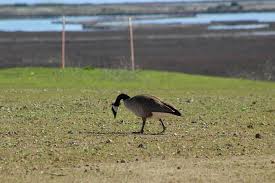LANSING — Chris Compton, the owner of Goose Busters, has spent nearly 30 years tackling conflicts between humans and geese, a problem that has only grown as the Canada goose population continues to rise across Michigan.
“Goose numbers are booming,” Compton explains, noting how geese are increasingly found in urban areas like Lansing, Ann Arbor, Troy, Detroit, and Auburn Hills. His business, based in Holly, is one of the many entities that assist in managing these birds, which are no longer restricted to rural areas.
From nearly disappearing in the mid-1900s due to over-hunting, the Canada goose population has now surged to about 280,000 in Michigan, according to the Department of Natural Resources (DNR). While the geese may be returning to their natural habitats, the environmental effects they leave behind are more noticeable, and potentially damaging.
One adult goose can produce up to two pounds of feces a day. This might not sound like much, but when multiplied by the thousands of geese inhabiting Michigan, it can quickly become a problem. Goose waste is rich in phosphorus and nitrogen, two elements that, when overabundant, lead to eutrophication in water bodies.
Eutrophication is the process where an excess of nutrients, particularly phosphorus, triggers the rapid growth of algae in water. This overgrowth, known as algal blooms, can disrupt ecosystems by consuming all available oxygen in the water, suffocating aquatic life. Research by Kristianstad University in Sweden explains how eutrophication can lead to a cycle of algae decomposition, further degrading water quality.
Alan Steinman, a researcher at the Robert B. Annis Water Resources Institute, elaborates, saying that decomposing algae release toxins into the water and surrounding environment, further harming both wildlife and plants. With an increase in agricultural runoff adding more phosphorus to the waterways, these blooms are flourishing unchecked.
While phosphorus is a limited resource in many environments, nitrogen, which also fuels algae growth, is harder to control. It originates from the atmosphere and continues to feed algae growth despite mitigation efforts. Steinman warns that we still lack definitive data on the precise impact of goose waste on water quality, but studies suggest that the presence of large populations of geese exacerbates the problem.
To prevent further harm, researchers recommend avoiding water with visible algae blooms. While humans are rarely harmed by exposure, pets are at a much higher risk of poisoning from ingesting contaminated water, which can be fatal. The most common symptoms of exposure to algae toxins include skin irritation and gastrointestinal distress, though these are not typically fatal in humans.
Another overlooked threat of goose feces is its role in spreading bacteria, parasites, and diseases that can affect both humans and animals. Although the risk to humans is considered minimal, handling goose droppings can still be dangerous. According to Barb Avers, a wetland specialist at the DNR, illness from goose waste is possible, though rare.
As climate change warms Michigan’s winters, more geese are opting to stay year-round. With milder winters, geese no longer need to migrate as far south, and they find adequate food and water without leaving the state. Thirty years ago, geese would travel to southern Illinois or Tennessee for the winter, but now, many stay as far north as Ohio.
The migration shift is having a significant impact on urban areas. While geese traditionally fed on natural grasses, urban landscapes with expansive lawns and ponds have created the ideal environment for them. The absence of natural predators has led to a sharp rise in local goose populations, contributing to a surge in human-geese conflicts.
The DNR has developed several protocols to manage the growing population. During the spring, the department destroys nests in areas with high goose populations, while the rest of the year is spent using scare tactics — including loud noises and border collies — to discourage geese from settling on properties. Unfortunately, efforts like capturing and relocating geese have proven ineffective, particularly after the arrival of avian flu in Michigan in 2022. Relocation efforts that previously moved up to 10,000 geese annually now face significant limitations due to the increasing goose population and the risk of spreading the disease.
In response to these challenges, businesses like Goose Busters offer services to manage local goose populations. Using trained border collies, Compton’s company helps drive geese away from properties experiencing issues with aggressive geese or excessive waste. While individuals can often scare off geese by simply using a dog or other deterrents, some areas require professional intervention to keep the birds away.
To sum up, as the Canada goose population continues to grow across Michigan, the state faces an increasing number of challenges. From environmental damage to public health risks, addressing these conflicts will require continued collaboration between wildlife experts, businesses, and local residents.
Disclaimer – Our team has carefully fact-checked this article to make sure it’s accurate and free from any misinformation. We’re dedicated to keeping our content honest and reliable for our readers.








